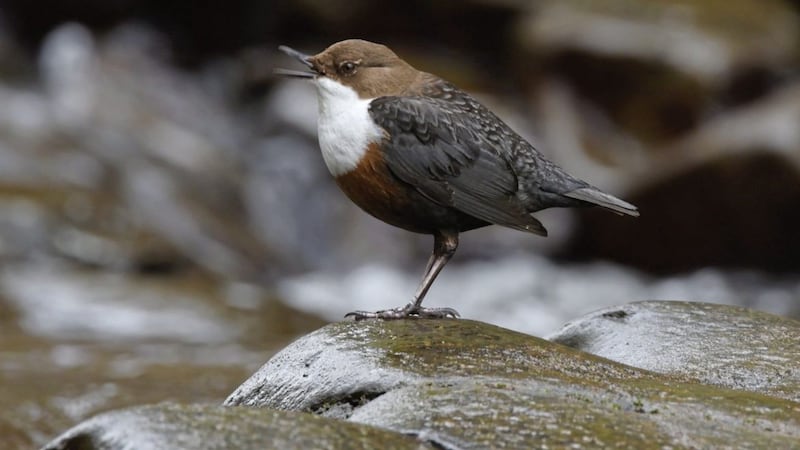A RECENT episode of the popular BBC programme Countryfile, which featured the dipper on a Scottish river, drew me back in time to a former workplace and my first ever encounter with Cinclus cinclus gularis or, to be more precise, Cinclus cinclus hibernicus as the Irish dipper is a subspecies with some subtle colour differences from its British counterpart.
A bird of fast-flowing, usually upland rivers, the dipper is frequently seen bobbing up and down on a submerged stone, defying the strong current, before diving under shallow water to search for aquatic insects. Perfectly balanced and equipped to probe in such turbulent and powerful waters, the bird will emerge and fly low and directly over the water, perhaps with some food for hungry chicks.
The dipper, short-tailed and dumpy, is chocolate brown above, with a distinctive white throat and breast and a narrow chestnut breast band lower down. This chestnut band is much narrower in the Irish race than the British dipper. Its powerful, squat build enables it to swim and walk underwater against the current to pursue its quarry effectively.
Its flight path along the river is unmistakable, low over the surface following the contours, very strong and purposeful. The name dipper is a clear reference to the bobbing motion of the bird with Cinclus coming from the Greek, meaning ‘tail-wagging bird’. Its overall dark coloration and shape no doubt earned it one of its Irish names, Lon abhann, river blackbird.
Glynn Anderson suggests in his book (Birds of Ireland; Facts, Folklore & History, 2008) that another Irish name, Gabha dubh, blacksmith, refers to its apron or bib-like white throat/breast. Lon uisce – water blackbird, is another name used.
Slightly smaller than a blackbird, the dipper nests in holes in the riverbank, often behind a waterfall or under a bridge. It is very sensitive to water quality changes and an excellent bio-indicator of the health of our rivers and streams.
No coincidence then that I saw my first dipper along the pristine waters of the Cladagh River, Co Fermanagh, a river sourced by three tributaries in the underground passages and chambers of the Marble Arch Cave system deep under the lower slopes of Cuilcagh Mountain.
Falling rain forms streams high up on the mountain, which soak through peat to run off the underlying sandstone and on to the more porous limestone where they disappear to the subterranean landscape of the caves and converge before emerging as a single river under the Marble Arch and out into the Cladagh glen.
It was here where, during a lunch break from guiding tourists through the caves, I saw this formidable and resilient bird. Now one of Ireland’s main tourist attractions and an important part of a Unesco (the United Nations Educational, Scientific and Cultural Organisation) Global Geopark designation, the caves, along with the Cladagh river and glen continue to be places of tranquillity and beauty for people and animals alike.
I came across the poem The Dipper (2003) by American poet Mary Oliver where she writes of seeing a dipper in Colorado, "more than half a century ago – on a rock-peak, starting up the clear, strong pipe of his voice" and with "there being no words to transcribe", she bent forward to catch through tone the, "cadence, sweetness and briskness of his affirmative report".
Though much less than half a century ago in my case, like Oliver, "still I hear him".
Fond memories of a striking bird and fascinating landscape.



